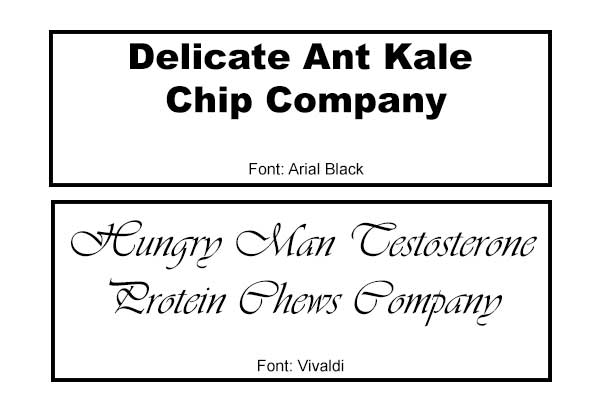Text is marketing
In the retail food industry, consumers spend a short amount of time deciding which products to buy from the crowded grocery store shelf. Typeface is an important aspect of food branding that can attract a consumer’s attention, and dollars.

Marketing can be thought of as every way in which a customer interacts with your product. Premium packaging, labeling content, location of sale and, of course, promotion all send messages to a potential buyer. A rather obvious category of marketing, however, is often neglected: typeface.
Typeface, simply put, are different fonts. Think: Times New Roman versus Arial font, for example1. The typeface that something is written in sends messages, separately even from the content itself. We know this intuitively. This holds true in the hyper-competitive retail food industry.
 ‘The Role of Typeface in Packaging Design’, by Dr. Carlos Velasco and Dr. Charles Spence, notes the ways in which typeface affects consumers. How easy or difficult the text is to read. Which messages the typeface sends, and with what strength.
‘The Role of Typeface in Packaging Design’, by Dr. Carlos Velasco and Dr. Charles Spence, notes the ways in which typeface affects consumers. How easy or difficult the text is to read. Which messages the typeface sends, and with what strength.
Easy to read texts, in most cases, increase the customer’s valuation of a product. Such text is legible, shown against a contrasting background and uses a relevant typeface. You don’t want a buyer frustrated by not being able to read – and learn – about your product. The agreement between typeface messaging and word meaning also increases processing fluency. For instance, Delicate Ant Kale Chip Company could portray ‘delicate’ by using a lighter font than Ariel Black, as it is here. Hungry Man Testosterone Protein Chews Company, similarly, would seem more on-brand to the assumed target customer in a less flowing typeface than Vivaldi. Switching the typeface used in these two examples would increase processing fluency.
.jpg) Interestingly, the reverse trend can sometimes hold true. Making a text more difficult to read and understand can in some special circumstances increase valuation by adding an air of complexity, innovation or uniqueness to a product. For example, hard to read text is associated with higher quality, more expensive wines. Aligning your product with other, similar high quality products can, by itself, increase the value the consumer places on the product, enabling you to charge a higher price.
Interestingly, the reverse trend can sometimes hold true. Making a text more difficult to read and understand can in some special circumstances increase valuation by adding an air of complexity, innovation or uniqueness to a product. For example, hard to read text is associated with higher quality, more expensive wines. Aligning your product with other, similar high quality products can, by itself, increase the value the consumer places on the product, enabling you to charge a higher price.
Typeface also independently affects consumers in an emotional way. ‘The feeling value of lines’ famously studied the emotions people subtly feel from plain line, not drawn into letters. The angle of a slightly sloping line can determine if it, and the typeface based on it, is happy or sad. Thick, heavy type is identified with strength. Light type denotes grace or tenderness. Typeface can directly signal taste, too. Flavor association research, The Role of typeface in Packaging Design conducted by Dr. Charles Spence and Dr. Carlos Velasco, show that rounder shapes, and it is assumed rounder typeface, is recognized as sweet. Similarly, slanted shapes are viewed as more sour. Studies show all this matters. According to the article, Font appropriateness and brand choice, when seeing two identical products – one with appropriate font, the other not – consumers chose, in research trials, products with typeface appropriate labels twice as often.
Getting started may seem difficult. First ask: who is my target consumer? What are their likes? And, why would they buy my product? Then, line up marketing that best highlights the product benefits this group cares most about. Is your product a smooth and subtle kombucha? If so, perhaps an appropriate typeface with thin and soft lines should be used. Is your target customer of a certain gender? Look at the marketplace and what typeface is used, generally, for characteristically male products versus female products6. Much of this is intuitive.
For expertise in incorporating consistent marketing and building a strong brand, consider utilizing the MSU Product Center. The MSU Product Center is an organization that brings together on-campus expertise in the sectors of food, agriculture, forestry and natural resources to help entrepreneurs define and launch innovative products. Field-based innovation counselors advise entrepreneurs on business planning, regulatory requirements and product development needs. To access business development assistance, select the ‘request counseling’ tab on the MSU Product Center website or call 517-432-8750.



 Print
Print Email
Email
